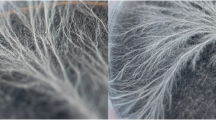Abstract
In this paper, we present a series of design methodologies which have emerged from the interaction of living (material) and non-living (machine) behaviours. ‘Bio Scaffolds’ explores a series of design tectonics that emerge from the co-creation between human, machine and natural intelligences. This research examines mycelium’s ability to biodegrade architectural forms, augmenting and modifying form generation. By hacking the degradation rates of natural materials, sacrificial formworks (Snooks, Towards a robotic architecture, 2018) act as non-anthropocentric architectural habitats for mycelium to grow and eventually biodegrade. To manipulate natural growth, dynamic feedback systems are explored. Here, machine, nature and computational form are in constant dialogue with one another. A negotiation between architectural aesthetics and biological agency is investigated, establishing an integral connection between form and materiality. Using this hybrid intelligence—developed at the nexus of human, machine, and mycelium—the intention is to generate unexpected forms, showcased through a series of 3D printed mycelium enclosures. A robotic arm is introduced into the system that can respond to the organism’s natural behaviour by injecting additional mycelium culture into sacrificial frameworks. Equipped with a computer vision system, feedback controls, scanning procedures and a multi-functional end-effector, the machine tends to nature by reacting to its patterns of growth, moisture, and color variation. As the organism begins to grow within the designed geometry, the robot detects and responds to this data by injecting additional mycelium culture into the sacrificial formworks.








Similar content being viewed by others
References
Alan, W.: D’arcy Thompson’s ‘On Growth and Form’ and the rediscovery of geometry within the geographic tradition. Scott. Geograph. J. 126(4), 231–257 (2010)
Anker, P.: Science in culture: Bauhaus at the zoo. Nature 439(7079), 916 (2006). https://doi.org/10.1038/439916a
Appels, F.V.W., Camere, S., Montalti, M., Karana, E., Jansen, K.M.B., Dijksterhuis, J., Krijgsheld, P., Wösten, H.A.B.: Fabrication factors influencing mechanical, moisture- and water-related properties of mycelium-based composites. Mater. Design 161, 64–71 (2019)
Barry Cooper, S., Maini, P.K.: The mathematics of nature at the Alan Turing Centenary. Interface Focus 2(4), 393–396 (2012)
Cruz, M.: The Inhabitable Flesh of Architecture. Routledge, New York (2013)
Dessi-Olive, J.: Monolithic mycelium: growing vault structures. In: Editor, F., Editor, S. (eds.) 18th International Conference Materials and Technologies, pp. 1–12. Nairobi Kenya (2019)
Duro Royo, J., Mogas Soldevilaa, L., Oxman, N.: Physical feedback in fabrication information modeling. In: Media Lab, Mediated Matter Group. eCAADe 2015—33rd Annual Conference—REAL TIME: Extending the Reach of Computation (2015)
Haeckel, E.: “Haeckel’s artforms in Nature (1904)
Heisel, F., Lee, J., Schlesier, K., Rippmann, M., Saeidi, N., Javadian, A., Nugroho, A., Mele, T., Block, P., Hebel, D.: Design, cultivation and application of load-bearing Mycelium components: the MycoTree at the 2017 Seoul Biennale of Architecture and Urbanism. Int. J. Sustain. Energy Dev. 6(1), 296–303 (2018)
Jones, M., Tien, H., Chaitali D., Fugen D., Sabu J.: Mycelium Composites: A Review of Engineering Characteristics and Growth Kinetics. J Bionanoscie 11(4), 241–257 (2017). https://doi.org/10.1166/jbns.2017.1440
Jones, M., Weiland, K., Kujundzic, M., Theiner, J., Kählig, H., Kontturi, E., John, S., Bismarck, A., Mautner, A.: Waste-derived low-cost mycelium nanopapers with tunable mechanical and surface properties. Biomacromolecules 20(9), 3513–3523 (2019). https://doi.org/10.1021/acs.biomac.9b00791
Oxman, N.: Material-based design computation. PhD Thesis, University of Massachusetts Institute of Technology, Massachusetts, USA (2004)
Retsin, G.: Computational Design (Neil Leach and Phillip Yuan). Tongji University (2018)
Snooks, R.: Behavioral Formation: Multi Agent Algorithmic Design Strategies. School of Architecture and Design College of Design and Social Context RMIT University Australia (2014)
Snooks, R.: Computational Design. Edited by Neil Leach and Philip F Yuan. Tongji University Press Co., Ltd (2018a)
Snooks, R.: Review of Sacrificial Formation. Edited by Daas Mahesh and John Wit Andrew. Towards a Robotic Architecture, pp. 104–117 (2018b). https://www.worldcat.org/title/towardsa-robotic-architecture/oclc/992570355
Snooks, R., Jahn, G.: Closeness: on the relationship of multi-agent algorithms and robotic fabrication. In: Reinhardt, D., Burry, J., Saunders, R. (eds.) Proceedings of the 2016 Robotic Fabrication in Architecture, Art and Design, Sydney, Australia, 14–17, pp. 218–229 (2016)
Statement, P.: Mycelium Running: How Mushrooms Can Save the World, 1st edn. Random House, Berkley (2017)
Xing, Y., Brewer, M., El-Gharabawy, H., Griffith, G., Jones, P.: Growing and testing Mycelium bricks as building insulation materials. IOP Conf. Ser. Earth Environ. Sci. 121(2), 022032. https://doi.org/10.1088/1755-1315/121/2/022032
Author information
Authors and Affiliations
Corresponding author
Additional information
Publisher's Note
Springer Nature remains neutral with regard to jurisdictional claims in published maps and institutional affiliations.
Rights and permissions
About this article
Cite this article
Alima, N., Snooks, R. & McCormack, J. Bio Scaffolds: the orchestration of biological growth through robotic intervention. Int J Intell Robot Appl 6, 522–529 (2022). https://doi.org/10.1007/s41315-021-00218-8
Received:
Accepted:
Published:
Issue Date:
DOI: https://doi.org/10.1007/s41315-021-00218-8




